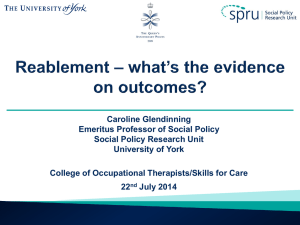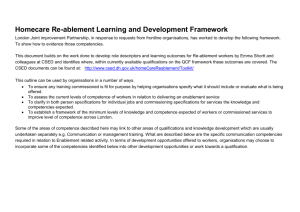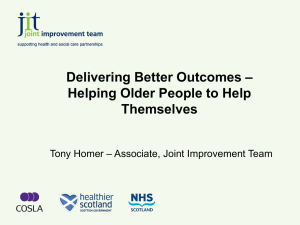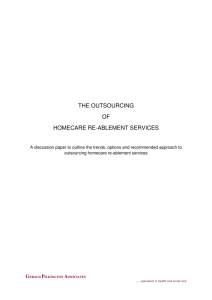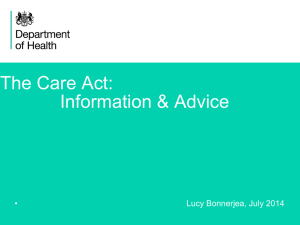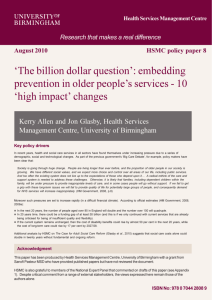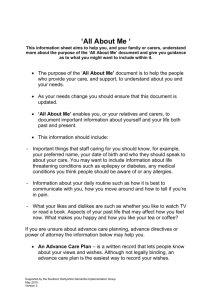Carrying out equality based impact assessments
advertisement
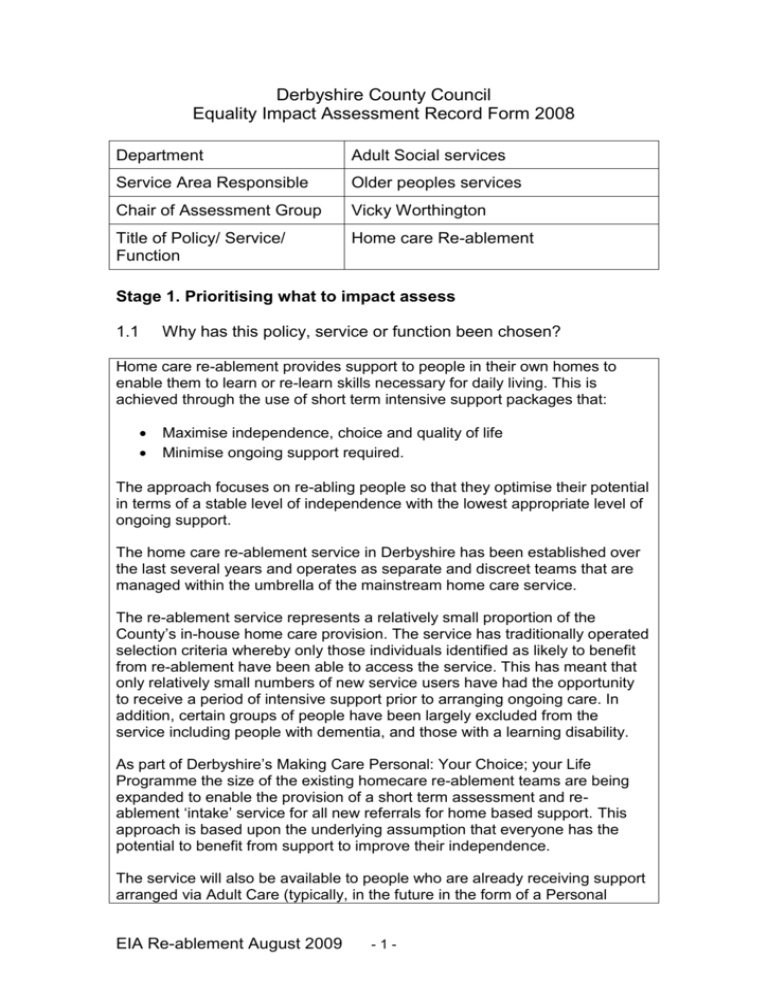
Derbyshire County Council Equality Impact Assessment Record Form 2008 Department Adult Social services Service Area Responsible Older peoples services Chair of Assessment Group Vicky Worthington Title of Policy/ Service/ Function Home care Re-ablement Stage 1. Prioritising what to impact assess 1.1 Why has this policy, service or function been chosen? Home care re-ablement provides support to people in their own homes to enable them to learn or re-learn skills necessary for daily living. This is achieved through the use of short term intensive support packages that: Maximise independence, choice and quality of life Minimise ongoing support required. The approach focuses on re-abling people so that they optimise their potential in terms of a stable level of independence with the lowest appropriate level of ongoing support. The home care re-ablement service in Derbyshire has been established over the last several years and operates as separate and discreet teams that are managed within the umbrella of the mainstream home care service. The re-ablement service represents a relatively small proportion of the County’s in-house home care provision. The service has traditionally operated selection criteria whereby only those individuals identified as likely to benefit from re-ablement have been able to access the service. This has meant that only relatively small numbers of new service users have had the opportunity to receive a period of intensive support prior to arranging ongoing care. In addition, certain groups of people have been largely excluded from the service including people with dementia, and those with a learning disability. As part of Derbyshire’s Making Care Personal: Your Choice; your Life Programme the size of the existing homecare re-ablement teams are being expanded to enable the provision of a short term assessment and reablement ‘intake’ service for all new referrals for home based support. This approach is based upon the underlying assumption that everyone has the potential to benefit from support to improve their independence. The service will also be available to people who are already receiving support arranged via Adult Care (typically, in the future in the form of a Personal EIA Re-ablement August 2009 -1- Budget and Support Plan), but whose needs have changed significantly, and where assessment identifies re-ablement would be beneficial. The development of a universal home care re-ablement service is a key component of the ‘Putting People First’ approach to adult social care provision in Derbyshire and comes within the overarching policy on self directed support, sharing the same goal of promoting independence health and wellbeing, while improving service users’ choice and control over the care and support they receive. This equality impact assessment (EIA) will help identify any possible adverse impacts of the service on different equality groups and ensure that effective action is taken to address these. 1.2 Why does the policy, service or function exist/ what is its purpose? Who should benefit? The white paper Our Health Our Care Our Say (DH 2006) mandates investment in services which promote independence, wellbeing and choice for all adults. The focus is on services which promote care closer to home, and the prevention of avoidable admissions into long term care. The cross Government Putting People First Concordat (2007) builds upon the white paper and sets the direction of social care for the next decade and beyond. Key themes include prevention, early intervention, re-ablement and personalised services. These changes are also being driven by the need to develop ways of working that reduces pressure on long term services due to demographic changes these include: Demand for homecare will increase significantly over the next two decades. Projections for Derbyshire indicate that the population of those over 65 years is predicted to grow 55% by 2028. Within this the number of aged over 85 years is predicted to grow 28% by 2018 and 82% by 2028. The proportion of people within the age bands that historically have provided care will reduce considerably over the next decade. This will have serious implications the capacity of care agencies to maintain sufficient workforce to meet demand. Changes to Eligibility criteria: This cannot provide a long term solution on its own as many people who do not fulfil the current criteria are likely to deteriorate and may present with a higher level of need at a later stage. As highlighted by CSED (2007) simply raising the bar is unlikely to make economic sense within a prevention agenda. To address these key challenges home care re-ablement is now firmly on the social care agenda, and there is a growing body of national evidence EIA Re-ablement August 2009 -2- indicating that the approach can increase peoples independence, and significantly reduce the subsequent use of homecare services, and that the benefits can be sustained in the longer term (Newbronner et al 2007). The development of a universal re-ablement service in Derbyshire has been shaped largely in response to consultation with service users and other key stakeholders who have consistently told us that they want services to enable them to live more independently with dignity and respect. The service model will ensure that all adult citizens assessed as needing and being eligible for personal/practical assistance to maintain them at home will have access to the service which aims to: Maximise each individuals independence Prevent/delay the need for domiciliary care Reduce the level of domiciliary care required by those service users who need ongoing support Reduce the number of admissions to hospital/care homes Facilitate timely hospital discharge Provide a rapid response to those in crisis. Service users will be actively supported to participate as fully as possible in the design and delivery of their re-ablement service. This will be achieved by identifying and working towards outcomes that are important to each individual. Outcomes could include for example, improving self care, building confidence and self esteem, establishing/maintaining social activities and networks. The service will be flexible and responsive to individual needs with reablement packages personalised to take account of each service user’s lifestyle, preferences and choices. Importantly the role of family members and informal carers will be respected and their valuable contribution to re-ablement fully recognised. The service will initially be available from 6am-10pm seven days a week. However, detailed modelling is currently underway to assess the nature and level of demand for support after 10pm to enable the provision of a comprehensive 24 hour service. The service will be established across the County by the end of September 2009. EIA Re-ablement August 2009 -3- Stage 2. Pulling an assessment team together Name Area of expertise/ role (Chair) Vicky Worthington Project Manager Service re-design Jane Parke Project Manager Homecare Alice Sanghera Project Manager Commissioning Steve Philips Project Manager Quality Assurance Rachel Knox Re-ablement Service Manager Carla Jervis Re-ablement Domiciliary Service Organiser Stage 3. Scoping of the assessment / identifying likely issues The equality impact assessment will review the way the service is delivered including: Identifying who the service will impact on e.g. general public or specific groups Identify differential or negative impacts on sections of the community and people identified as belonging to equality groups Provide recommendations to address resolve these within the action plan including appropriate timescales. Identify information gaps Provide details of monitoring arrangements that will be implemented to ensure recommendations are effective. Stage 4: Pulling together all the information Name of source Reason for using 2001Census Joint Strategic Needs Assessment (JSNA) Local Area Agreements (LAA) Information on ReGARDS (Religion, Gender, Age, Race Disability, Sexuality and Gender identity) communities. Demographic trends and projections of future service demands. EIA Re-ablement August 2009 -4- Best Value review of home Based services Management information Satisfaction surveys (Perspective 34) Individual service users Literature review Race equality Scheme 2008-2010 Stage 5. 5.1 Review of performance against national and local targets Information on stakeholder views and recommendations for service improvements Data on current activity relating Data on current activity relating to the provision of homecare Information on levels of service user satisfaction with home care in Derbyshire Consultation on individuals experience of home based services Research relating to the implementation of universal reablement services nationally Updated information on profile of Derbyshire Black and Minority Ethnic (BME) Communities Assessing the impact or effects What does customer feedback, complaints, and discussions with stakeholder groups tell you about your service, policy and function, including which aspects are seen as negative, inaccessible, unhelpful, difficult to use etc? Nationally the majority of people (some 80%) wish to live independently within their own homes for as long as possible (DH 2006). In addition, people will no longer accept being the passive recipients of care and rightly expect that they will be actively involved in selecting and shaping the services they receive. Whatever their age people consistently tell us that they want to have practical and personal assistance that: Offers choice and control Promotes independence Treats them with respect Preserves their dignity (CSCI 2006) Nationally surveys of service users’ views usually demonstrate high levels of satisfaction with home care. This is reflected in the overall results of Derbyshire’s recent consultation exercise undertaken by the performance review team that identified 93% of respondents were extremely, very, or fairly EIA Re-ablement August 2009 -5- satisfied with the home care service they receive. Some specific examples are as follows: Over 90% agreed their care worker (s) always or nearly always did the things they wanted done Almost 85% of respondents said their workers always or usually came at suitable times Over 95% stated that their carer stayed as long as expected 97% stated that they got up and went to be at times that suited them 97% stated they felt their workers were excellent at their job 98% felt that their workers treated them with respect and dignity and were obliging. Although satisfaction ratings from standard surveys are generally high recent research found that more detailed interviews and group discussions tend to elicit more critical feedback. A study carried out by CSCI in 2006 paints a mixed picture of the quality of home based support with many service users finding the task based approach inflexible and insensitive to their needs. Importantly, some of the responses in Derbyshire’s survey found that the appreciation expressed towards individual workers is tempered by concerns that carers do not always have enough time to work in ways that support independence. “They are wonderful ..... but how much better life would be if they had more time.” “Often they seem time pressed and I feel obliged to rush.” Whilst the in-house home care service is highly valued by Derbyshire citizens and achieves many positive outcomes for service users, the traditional model of provision does impose constraints on service innovation and the development of better personalised services. This is reflected in the Council’s Best Value review which identified the need for a number of service improvements particularly in relation to more inclusive and effective approaches to re-ablement. Those service users and stakeholders consulted about the development of a universal re-ablement service felt that this could help achieve more positive outcomes for people in terms of improved independence and wellbeing. However, some concerns were raised that any gains may be lost if longer term mainstream and independent providers fail to work to a re-ablement ethos. EIA Re-ablement August 2009 -6- 5.2 What does your information tell you about the effects of the policy, service or function on the lives of different groups or communities? Is any of this negative or unwanted? Groups Effects identified from data/ information All ReGARDS The traditional re-ablement service has focussed very much upon a task orientated approach to functional Independence. The universal re-ablement service is designed to provide a broad enabling role taking account of much wider social issues, personal aspirations and goals. It is recognised there may be issues relating to how effective the service will be in delivering more personalised support packages that promote not only functional independence but also support and enhance opportunities for inclusion and equality. All ReGARDS Failure to develop a whole systems approach will result in mainstream and independent providers of ongoing home care being unable to ensure the gains from re-ablement are sustained. All ReGARDS Service user satisfaction with home care services has been analysed globally, and not broken down into type of service or equality groups. It is therefore not possible from existing data to establish any negative impacts or identify potential patterns of discrimination. Older people represent the vast majority of service users who receive home care. Derbyshire’s overall population of older people will rise gradually but the increase will be most marked for those over 85 years. Therefore the service has been predominantly designed to meet the needs of high numbers of older People. There may be an issue as to how effective the service will be in meeting the needs of young adults of working age. Age Disability With a strong focus upon re-ablement and independence the service supports the social model of disability which recognises the social, environmental and attitudinal barriers faced by people with disabilities and the impact of these barriers. A strengthened focus on re-ablement should therefore extend opportunities for independent living. However, the current emphasis on physical reablement within the service limits potential benefits EIA Re-ablement August 2009 -7- and opportunities for working with people who have a learning disability or who are experiencing mental ill health People with Dementia People with dementia have historically been excluded from the re-ablement service. Again, as above there may be an issue with how effective the universal model will be in meeting the needs of those with dementia. Ethnicity Religion/belief Take up of Adult social services including existing domiciliary/re-ablement services is services is significantly lower (0.93%) than the size of these communities (4.3%) would suggest. Outcome focussed and person centred approaches have been developed to include the religion and cultural context of the person requiring support. However, further work is required to promote access to services to people from BME communities (see above). Gender The overwhelming majority of home care staff is female. This may compromise the ability of the service to respond to individuals who request carers of a specific gender to assist with personal care tasks (see also above). Sexuality and Gender Identity Person centred and Outcome focussed approaches seek to ensure the service is responsive to the needs of individuals regardless of sexual orientation or Gender identity. However information from Derbyshire friend suggests awareness of the support available through Adult social services is low within Lesbian, Gay Bisexual and Transgender (LGBT) communities. The authority does not currently monitor the sexual orientation of service users receiving a home care service. Gypsy and Traveller communities Despite significant health and social care needs these communities have traditionally experienced low levels of access to adult social care support EIA Re-ablement August 2009 -8- Stage 6. Ways of reducing or removing unwanted effects What small steps could be taken to achieve improvements? Please outline the main things that need to be altered to reduce any illegal, negative and unwanted impact. 1) In addition to the existing core training home care staff working as part of the re-ablement service (including DSO’s) will undertake a specially commissioned training programme focussing upon goal setting and reablement approaches with different service user groups. 2) A set of specific competencies for re-ablement staff will also be developed to reflect the national work being undertaken by Skills For Care, and the Care Services Efficiency Delivery Programme. Re-ablement training and skill based competencies will be designed to incorporate issues relating to equality and diversity. 3) To help develop whole systems approach re-ablement training will also be rolled out to the mainstream service and independent providers of home care. 4) Comprehensive performance and monitoring arrangements will be put in place to measure the effectiveness of the service. This will include take up of the service and outcomes for individuals broken down by equality groups to identify any potential patterns of discrimination. 5) Future service user consultation and satisfaction surveys will include specific questions to capture equalities information for example, the views of service users receiving support from re-ablement workers of opposite gender, and whether they were given a choice. Stage 7. Finding out whether your assessment has identified what people think needs changing. This assessment has been signed off by the assessment team. Further consultations will take place as an ongoing process through events/consultation exercises which will ensure the actions remain relevant and on track EIA Re-ablement August 2009 -9- EIA Re-ablement August 2009 - 10 - Stages 8 and 9 Action planning, target setting and monitoring TARGETS / SUCCESS CRITERIA LEAD RESP ACTION 1. Establish a universal home care reablement service in all areas of the County EIA Re-ablement August 2009 - 11 - VW PARTNERS Integrated care pathways have been agreed with health partners to ensure that service delivery fits with existing intermediate care provision RESOURCES PERFORMANCE INDICATORS/ MILESTONES The service will By end of be established September 2009 using approximately 25% of the overall inhouse capacity. This assumes the provision of approximately 5,500 hours of support per week at a cost of approximately £9million QUALITY ASSURANCE Of those who access reablement 20% will cease to receive a care package 30% will receive a reduced care package. (Based on a comparison of the level of support at the commencement of the service to the level of support at the end of the intervention LEAD RESP ACTION 2. Re-ablement training to be provided for all re-ablement staff. This will be designed to include re-ablement approaches with different service user groups, and issues relating to equality and diversity VW PARTNERS Skills for Care 3. Specific skills based competencies to be developed for re-ablement staff 4.Re-ablement training to be rolled out across the standard mainstream service and independent sector providers of home care EIA Re-ablement August 2009 - 12 - Skills for care Independent Providers RESOURCES PERFORMANCE INDICATORS/ MILESTONES QUALITY ASSURANCE To be delivered By end of by the staff September 2009 development team within the existing training budget Feedback from trainers and staff. Operational managers to monitor impact on service delivery and quality outcomes. Consultation with service users. Quality audits/inspection To be supported by staff development Feedback from operational staff and managers re impact upon developing best practice. Consultation with service users By end September 2009 To be delivered By end of 2010 through existing staff development Feedback from trainers, staff and operational LEAD RESP ACTION PARTNERS RESOURCES PERFORMANCE INDICATORS/ MILESTONES budget 5. Performance and monitoring arrangements to be put in place. To include take up of service and outcomes for individuals broken down by equality groups VW CSED ReGARDS Performance Review Team Management information QUALITY ASSURANCE managers Consultation with service users Quality audits/inspection By end of September 2009 Centrally collected information to be compared to data collected by responsibility centre managers Consultation with specific groups: ReGARDS, BME forums, partnership boards, DCIL etc. 6. Future service user consultation and satisfaction surveys to include questions to capture equalities information. EIA Re-ablement August 2009 - 13 - VW ReGARDS To be developed by the Performance Review Team By January 2010 Consultation with specific groups: ReGARDS, BME forums, partnership LEAD RESP ACTION PARTNERS RESOURCES PERFORMANCE INDICATORS/ MILESTONES QUALITY ASSURANCE boards, DCIL etc. EIA Re-ablement August 2009 - 14 - Step 10. Have your main actions been added to the relevant business or service plan(s)? Please indicate below which actions to which plans Action planned Actions 1-6 Business / Service Plan Business case and project plan How will performance be tracked and reported? The chair of the assessment group will produce regular highlight reports for scrutiny by the service re-design board. Overall scrutiny will be provided through the making Care personal Programme Board Step 11. Publishing your assessment Please indicate below:Your assessment has been signed off for publishing by Adult Social services Senior Management team (SMT) Your assessment was published on Medium/ location Date Signed Date EIA Re-ablement August 2009 - 15 -
